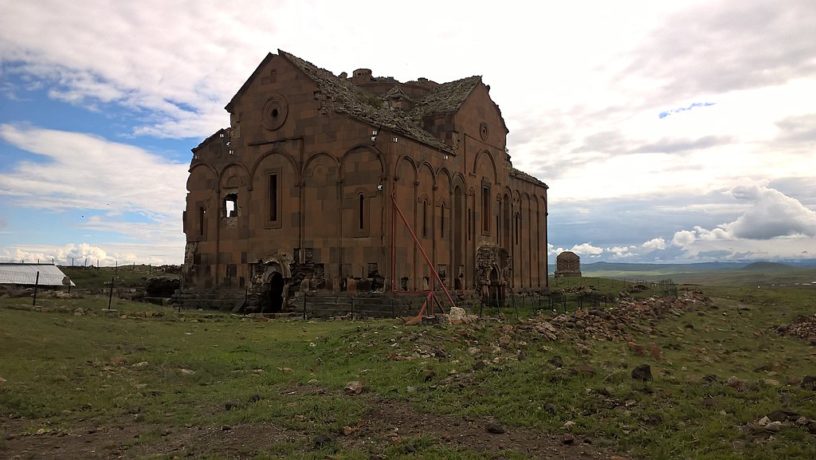
Ani ruins by Panegyrics of Granovetter from Wikimedia Commons
Top 6 Outstanding Facts about Ani, Turkey
On the old Silk Road, 42 kilometres (26 miles) east of the Kars province, is the medieval city of Ani (Ocakli), which is now mostly in ruins. Around the remains of various churches, mosques, and caravanserais are still impressive defensive walls.
Even though Ani was once the capital of the Bagratuni Kingdom and a historic Armenian village, it had to contend with waves of conquerors throughout the centuries, including Muslims, Byzantines, and Mongols. The city wasn’t abandoned until Asia Minor was under Mongol authority. Ani was never inhabited again beyond the 17th century after the inhabitants, who were primarily Armenian, were forced to depart in 1336.
Here are 6 facts you probably didn’t know about Ani.
1. Ani was regarded as one of the world’s endangered heritage sites

Georgian Church Ani Turkey by Ggia from Wikimedia Commons
Ani was neglected for many years, resulting in many of its architectural wonders being destroyed. Ani’s accessibility to the general public was severely constrained for a long time due to the historic city’s location in a disputed area of Turkey. Recently, though, things have changed, and Ani tourism has significantly risen.
In the past, a number of international heritage groups have occasionally shown their worry about Ani’s well-being. The Global Monument Fund listed Ani as one of the most endangered cultural landmarks in the world in 2010. The World Monument Fund and the Turkish Ministry of Culture finally started the repair of the monuments in Ani in 2011.
2. Ani’s buildings are made of the locally available volcanic basalt

Ani Harabeleri by Oktay Bölükbaşı from Wikimedia Commons
The volcanic basalt that is readily available in the area, which comes in a variety of natural hues including yellow, red, and black, is used to make Ani’s structures. These rocks’ supple nature also makes carving patterns into them simple.
A few of the notable examples of Ani’s architecture are the Church of the Holy Mother of God, which features pointed arches and clustered piers inside, the Church of St. Gregory of Tigran Honents, which has domed halls and magnificent stone carvings and frescoes, as well as a number of other churches, the Mosque of Manuchihr, the Citadel and City Walls, as well as the ruins of bathhouses, oil presses, bridges,
3. Ani was tied to a lot of Armenian cultures

Ruins in Citadel by Ggia from Wikimedia Commons
There are numerous accounts of invasions, arson, and earthquakes throughout Ani’s history. Located in a military area close to the disputed border between Turkey and Armenia, this historic city is currently nearly entirely abandoned. Most of the structures in this area are in ruins, and what remains of them are scattered extensively around the area’s mountainous, forested environment.
The church of the Christ the Redeemer, which has a crack running straight through it that represents a lightning strike in the past, is one of the most distinctive features in this area. The archaeological remains at Ani give historians important information on ancient Armenian culture, way of life, art, and architecture.
4. In 1319, a devastating earthquake struck the city
The city was extremely affluent and extensively affected by major global civilizations, which is visible in the art and architectural artefacts that still exist today. The city stood at the intersection of the old international commerce route. The population of the city peaked at about 100,000 people.
When the Mongols invaded Ani in 1236, they began the destruction of this splendid city by pillaging its treasures and plundering its buildings. A terrible earthquake that hit the city in 1319 caused many of its structures to collapse and caused significant destruction, causing the population’s subsequent years of an exodus.
5. There are many historical remains in Ani

Ani Ruins by Panegyrics of Granovetter from Wikimedia Commons
At Ani, there are several other little monuments. The Virgins’ Chapel convent, a church frequented by Chalcedonian Armenians, the ruins of a single-arched bridge over the Arpa River, numerous oil presses and bathhouses, the remains of a second mosque with a collapsed minaret, a palace thought to date from the 13th century, the foundations of numerous other palaces and smaller residences, the recently excavated ruins of several streets lined with shops, etc., are among these.
6. Ani’s golden age ended with the death of King Gagik in 1020
With the death of King Gagik in 1020, when Armenian sovereignty was divided between his two sons, Ani’s heyday came to an end. In an effort to stop an invasion, the son who governed Ani proclaimed the Byzantine Emperor his successor in a series of political events that came to establish the term “Byzantine.”
The Byzantine Emperor declared his claim to the city after his death, but the new King of Ani broke his word and drove the Emperor’s soldiers out. But only three years later, after a string of military setbacks for the Armenians and a pro-Byzantine insurrection in Ani, the city submitted to Byzantine rule.
Due to its location directly on the Turkish-Armenian border, Ani was a military zone for a significant amount of time throughout the Republic era, during which time you need a formal permit to enter. The permission is no longer required because the prohibition was subsequently lifted.
You may easily get your ticket to access the archaeological site by going to Ani. The Cathedral, the Church of St. Stephanos, the Church of St. Gregory of Tigran Honents, the Church of the Holy Redeemer, the Mosque of Manuchihr, the City Walls, and several others—most of them in ruins—are among the most significant buildings at the site.
Planning a trip to Paris ? Get ready !
These are Amazon’s best-selling travel products that you may need for coming to Paris.
Bookstore
- The best travel book : Rick Steves – Paris 2023 – Learn more here
- Fodor’s Paris 2024 – Learn more here
Travel Gear
- Venture Pal Lightweight Backpack – Learn more here
- Samsonite Winfield 2 28″ Luggage – Learn more here
- Swig Savvy’s Stainless Steel Insulated Water Bottle – Learn more here
Check Amazon’s best-seller list for the most popular travel accessories. We sometimes read this list just to find out what new travel products people are buying.









